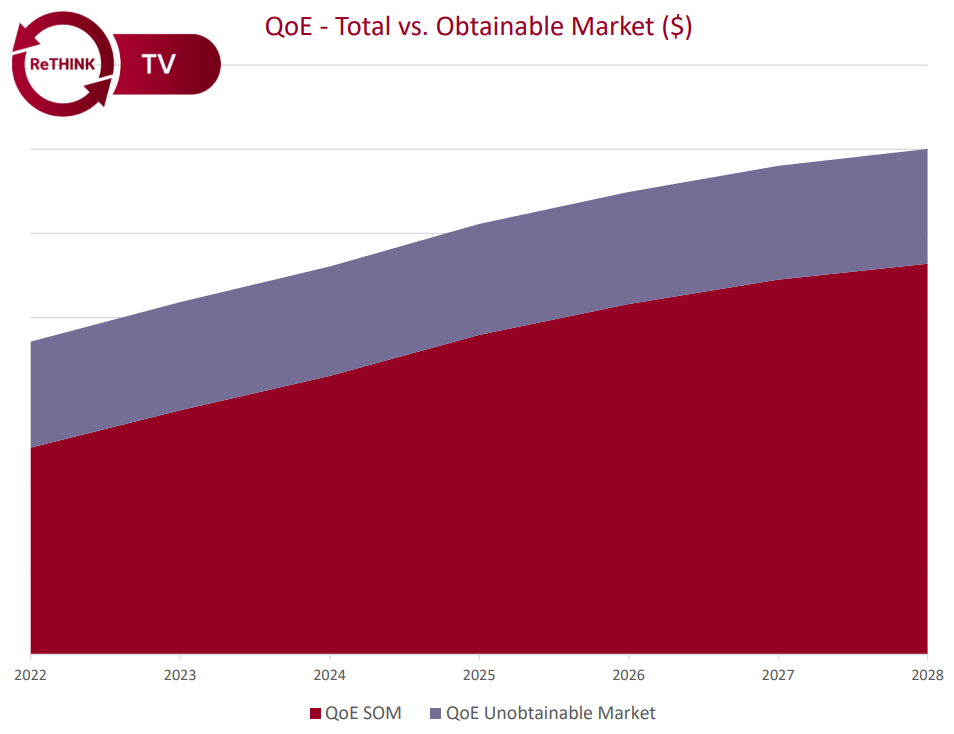
The market for technology for improving streaming video is expected to peak over the next five years but growth will flatten after that, according to a new report from researcher Rethink TV.
The Service Obtainable Market (SOM) for Embedded QoE Agents is set to hit over $9 billion by 2028, but strong growth over the next five years will flatten off towards 2028, in the face of a sharp drop in pricing for vendors and an OTT video market entering maturity.
Considering that the term “broadcast quality” is the gold standard for television, Rethink TV says streaming services have yet to achieve that goal.
“Amid the unstoppable rise of OTT, it is too often forgotten that IP-delivered video still has a long way to go when it comes to catching up with the reliability of linear, Pay TV networks,” the researcher said. “OTT services have usurped Pay TV when it comes to offering consumers an endless buffet of choice, but they still regularly suffer from infuriating buffering windows and highly variable picture quality.
“In many ways, this poor user experience is the final obstacle to OTT wiping out Pay TV altogether, and yet these issues have persisted for over 20 years,” it adds. “While Quality of Experience (QoE) is no longer a bleeding-edge technology, it is no less essential than it was at the dawn of streaming. “
However, QoE is now amid various layers of consolidation, the researcher said with QoE tools are being folded into wider analytics suites with tools like Quality of Service (QoS) and customer management. Meanwhile, analytics technologies have become one of many modules available via the ‘end-to-end’ video technology suites that are generally referred to as online video platforms (OVPs).
This consolidation will continue to lower the price of the standalone technologies, with QoE being no exception. Add to that a maturing OTT market, where brand new, rapidly expanding vide services are increasingly rare, and Rethink TV sees a QoE market that is soon to plateau.
Rethink TV’s report examines the market for “embedded agents”—QoE systems that report performance data directly from within the video player. Once integrated with the player, Embedded Agents can report metrics such as re-buffering ratio (which is the buffering time versus playback time), video start time, video start failures and average bitrate.
The professional video industry's #1 source for news, trends and product and tech information. Sign up below.
However there are other vendors in the QoE ecosystem—”external agents” such as Witbe, Suitest and (arguably) SIMMWave, also assess QoE, but this using external software and hardware tools to imitate an end user.
Although the end goal is similar, these two camps offer entirely different business models. Embedded agents are employed to monitor all activity on a video service whereas external agents are deployed far more sparingly due to much higher integration and upkeep costs.
Despite the irrefutable tide that will propel OTT video to become the dominant form of video consumption, IP-delivered video still has a long way to go when it comes to catching up with the reliability of linear Pay TV networks, the researcher said. OTT services have usurped Pay TV when it comes to offering consumers an endless buffet of choice, but they still regularly suffer from infuriating buffering windows and highly variable picture quality. In many ways, this poor user experience is the final obstacle to OTT wiping out Pay TV altogether, and yet these issues have persisted for over 20 years.
While perfecting network infrastructure is essential, any such repairs are being done blind without first knowing how and when the user experience suffers. Quality of Experience (QoE) tools therefore arrived soon after IP-delivered video, around 20 years ago, and while they are no longer a bleeding-edge technology, they are no less essential than they were back then, Rethink TV concluded.
Tom has covered the broadcast technology market for the past 25 years, including three years handling member communications for the National Association of Broadcasters followed by a year as editor of Video Technology News and DTV Business executive newsletters for Phillips Publishing. In 1999 he launched digitalbroadcasting.com for internet B2B portal Verticalnet. He is also a charter member of the CTA's Academy of Digital TV Pioneers. Since 2001, he has been editor-in-chief of TV Tech (www.tvtech.com), the leading source of news and information on broadcast and related media technology and is a frequent contributor and moderator to the brand’s Tech Leadership events.


